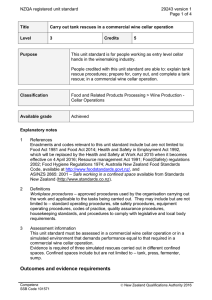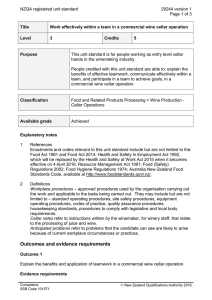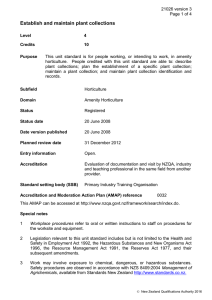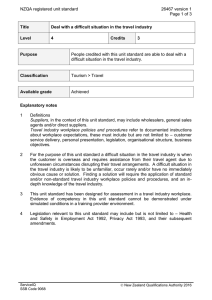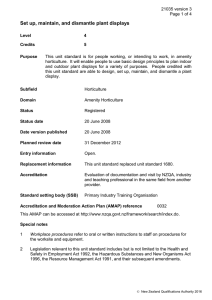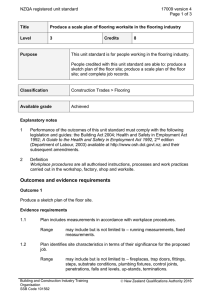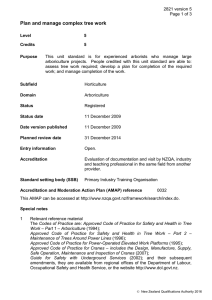NZQA registered unit standard 29248 version 1 Page 1 of 4
advertisement
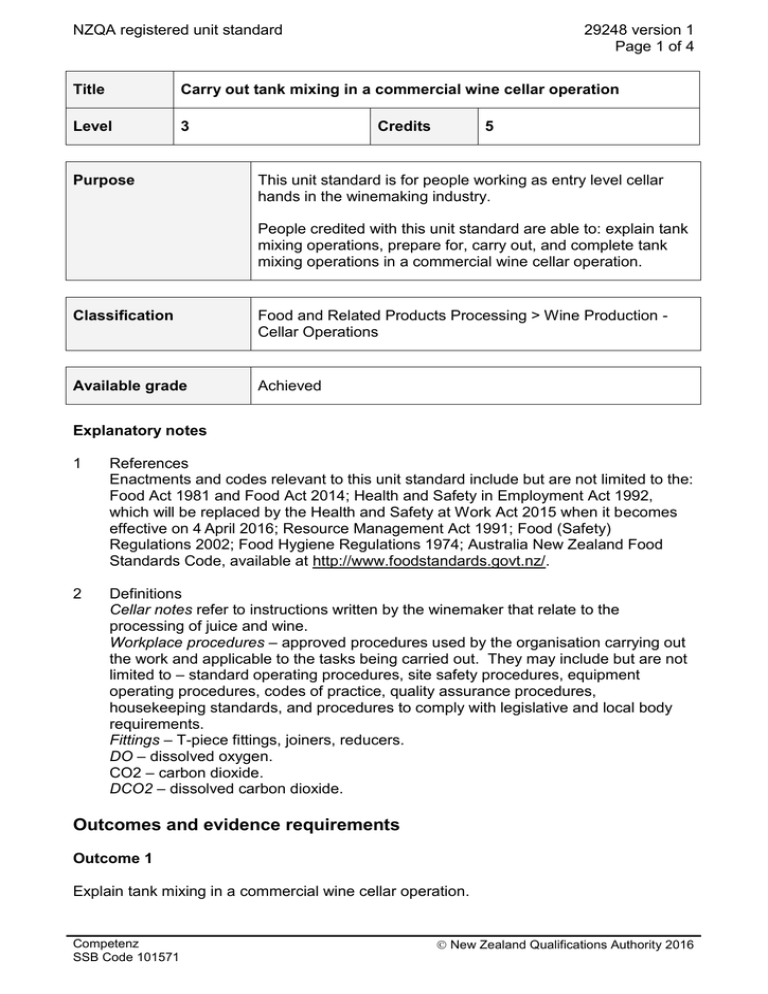
NZQA registered unit standard 29248 version 1 Page 1 of 4 Title Carry out tank mixing in a commercial wine cellar operation Level 3 Purpose Credits 5 This unit standard is for people working as entry level cellar hands in the winemaking industry. People credited with this unit standard are able to: explain tank mixing operations, prepare for, carry out, and complete tank mixing operations in a commercial wine cellar operation. Classification Food and Related Products Processing > Wine Production Cellar Operations Available grade Achieved Explanatory notes 1 References Enactments and codes relevant to this unit standard include but are not limited to the: Food Act 1981 and Food Act 2014; Health and Safety in Employment Act 1992, which will be replaced by the Health and Safety at Work Act 2015 when it becomes effective on 4 April 2016; Resource Management Act 1991; Food (Safety) Regulations 2002; Food Hygiene Regulations 1974; Australia New Zealand Food Standards Code, available at http://www.foodstandards.govt.nz/. 2 Definitions Cellar notes refer to instructions written by the winemaker that relate to the processing of juice and wine. Workplace procedures – approved procedures used by the organisation carrying out the work and applicable to the tasks being carried out. They may include but are not limited to – standard operating procedures, site safety procedures, equipment operating procedures, codes of practice, quality assurance procedures, housekeeping standards, and procedures to comply with legislative and local body requirements. Fittings – T-piece fittings, joiners, reducers. DO – dissolved oxygen. CO2 – carbon dioxide. DCO2 – dissolved carbon dioxide. Outcomes and evidence requirements Outcome 1 Explain tank mixing in a commercial wine cellar operation. Competenz SSB Code 101571 New Zealand Qualifications Authority 2016 NZQA registered unit standard 29248 version 1 Page 2 of 4 Evidence requirements 1.1 Reasons for tank mixing are explained in accordance with oenology principles. Range 1.2 red wine, white wine. Tank mixing is described in terms methods and equipment used. Range four of – submersible pump, pumping over, gas sparging, tank valve to valve, over the top, tank agitator, CO2 pellets, barrel stirrer. 1.3 Type of pumps and fittings used in mixing operations are described in terms of their principles of operation and application to different mixing methods. 1.4 The quality control parameters for tank mixing of red wine and white wine are explained in accordance with workplace procedures. Range parameters may include but are not limited to – product specification, DO levels, DCO2 levels. Outcome 2 Prepare for tank mixing in a commercial wine cellar operation. Evidence requirements 2.1 Potential hygiene and safety hazards are identified, and the steps required to control them are explained and used, in accordance with workplace procedures. 2.2 Instructions in cellar notes relating to the tanks, wine, and mixing method are interpreted in accordance with workplace procedures. 2.3 Cleaning and sanitising of the equipment are confirmed in accordance with workplace procedures. 2.4 Equipment is connected, and set up is verified by supervisor, in accordance with workplace procedures. Range 2.5 may include but is not limited to – valves, instrumentation, pump, inert gas system. Additives required for the mixing process are confirmed and quality and availability is established in accordance with workplace procedures. Outcome 3 Carry out tank mixing in a commercial wine cellar operation. Evidence requirements 3.1 Tank mixing is carried out in accordance with workplace procedures. Competenz SSB Code 101571 New Zealand Qualifications Authority 2016 NZQA registered unit standard 29248 version 1 Page 3 of 4 3.2 Sampling and quality control checks are carried out in accordance with workplace procedures. 3.3 Deviations from normal operating conditions are identified, and corrective actions are taken, in accordance with workplace procedures. deviations may include but is not limited to – vapour lock, pressure differential, operator error, spills, leaks, excess flow, contamination, pump and valve malfunction, instrument malfunction, overflow; Evidence of corrective action for three different deviations is required. Range Outcome 4 Complete tank mixing operations in a commercial wine cellar operation. Evidence requirements 4.1 Tank mixing operations are verified as complete and equipment is shut down in accordance with workplace procedures. may include but is not limited to – shutdown, water push through, isolation, disconnection. Range 4.2 Waste and sub standard materials are handled, disposed of, or recycled in accordance with workplace procedures. 4.3 Equipment is cleaned and stored in accordance with workplace procedures. 4.4 Documentation is completed, and the results of the tank mixing are communicated in accordance with workplace procedures. Planned review date 31 December 2019 Status information and last date for assessment for superseded versions Process Version Date Last Date for Assessment Registration 1 19 November 2015 N/A Consent and Moderation Requirements (CMR) reference 0013 This CMR can be accessed at http://www.nzqa.govt.nz/framework/search/index.do. Please note Providers must be granted consent to assess against standards (accredited) by NZQA, before they can report credits from assessment against unit standards or deliver courses of study leading to that assessment. Competenz SSB Code 101571 New Zealand Qualifications Authority 2016 NZQA registered unit standard 29248 version 1 Page 4 of 4 Industry Training Organisations must be granted consent to assess against standards by NZQA before they can register credits from assessment against unit standards. Providers and Industry Training Organisations, which have been granted consent and which are assessing against unit standards must engage with the moderation system that applies to those standards. Requirements for consent to assess and an outline of the moderation system that applies to this standard are outlined in the CMRs. The CMR also includes useful information about special requirements for organisations wishing to develop education and training programmes, such as minimum qualifications for tutors and assessors, and special resource requirements. Comments on this unit standard Please contact Competenz at qualifications@competenz.org.nz if you wish to suggest changes to the content of this unit standard. Competenz SSB Code 101571 New Zealand Qualifications Authority 2016
